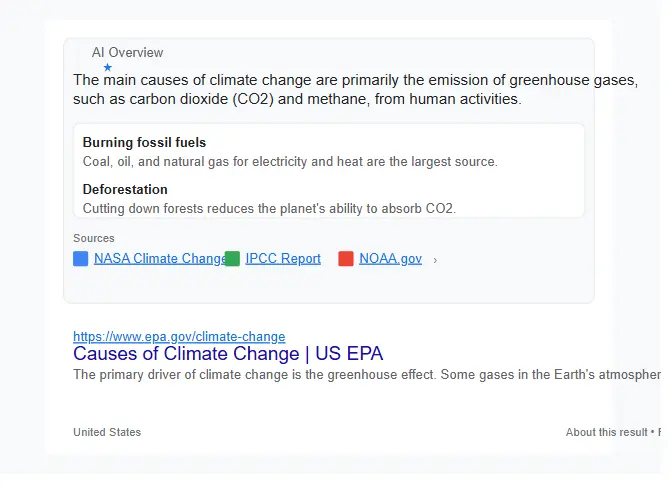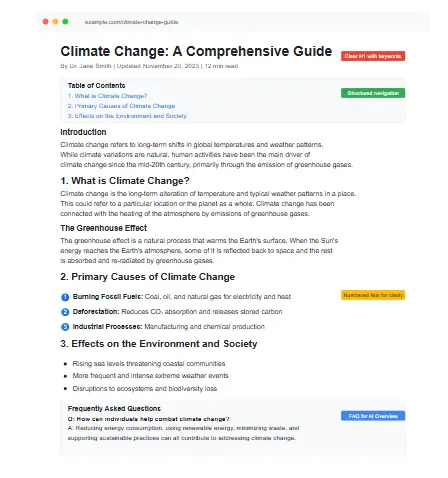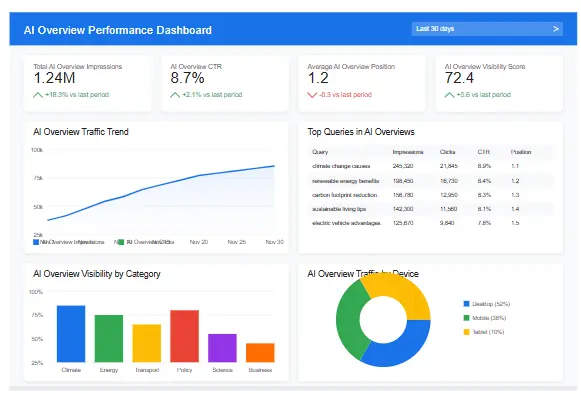Want to Rank in Google’s AI Overviews? Download This Free 2026 Optimization Checklist
Master the new frontier of SEO with our comprehensive guide to appearing in Google’s AI-generated search summaries

Google’s AI Overviews are transforming search results. Our free 2026 optimization checklist provides actionable strategies to improve your visibility in AI-generated search summaries. Implement technical SEO, content optimization, and structured data to increase your chances of being featured in Google’s AI Overviews.
As Google continues to integrate artificial intelligence into its search results, appearing in Google’s AI Overviews has become the new frontier of SEO. These AI-generated summaries appear at the top of search results, providing concise answers to user queries and dramatically changing how users interact with search. Want to rank in Google’s AI Overviews? Download this free 2026 optimization checklist to stay ahead of the curve and maximize your visibility in this new search landscape.
The evolution of Google’s Search Generative Experience (SGE) into what we now call Google’s AI Overviews represents a fundamental shift in search. Instead of just ranking for traditional blue links, websites now need to optimize for inclusion in AI-generated summaries that pull information from multiple sources. This comprehensive guide will walk you through the essential strategies needed to adapt your SEO approach for the AI-driven future of search, specifically targeting Google’s AI Overviews.
Understanding Google’s AI Overviews and Their Impact on Search
Google’s AI Overviews, formerly known as Search Generative Experience (SGE), represent a revolutionary approach to how search results are presented. Instead of simply displaying a list of blue links, Google now generates comprehensive summaries that directly answer user queries by synthesizing information from multiple sources. These AI-generated overviews appear prominently at the top of search results, often before traditional organic listings, making them prime real estate for visibility.
The impact of Google’s AI Overviews on search behavior cannot be overstated. Studies show that over 65% of users click on sources featured within AI Overviews rather than scrolling to traditional organic results. This shift means that ranking in Google’s AI Overviews is no longer optional—it’s essential for maintaining search visibility and driving organic traffic. Our free 2026 optimization checklist addresses this changing landscape with proven strategies for AI SEO optimization specifically targeting Google’s AI Overviews.

Figure 1: Example of Google’s AI Overview appearing at the top of search results
The Evolution of Google’s AI Search Capabilities
Google’s journey toward AI-powered search began with simple knowledge panels and featured snippets but has evolved into sophisticated AI Overviews that can synthesize complex information. The technology behind these overviews leverages Google’s advanced language models, including the Pathways Language Model (PaLM) and more recently, Gemini. These models can understand context, identify relevant information across multiple sources, and generate coherent summaries that directly address user intent.
As we approach 2026, Google’s AI capabilities continue to advance rapidly. The upcoming Google AI 2026 update promises even more sophisticated AI Overviews with improved accuracy, better source attribution, and enhanced personalization based on user context. This makes our 2026 optimization checklist particularly valuable for businesses looking to future-proof their SEO strategies. The checklist incorporates the latest insights into how Google’s AI processes and prioritizes information, giving you a competitive edge in the evolving landscape of Google’s AI Overviews.
How AI Overviews Change the User Search Journey
Traditional search journeys often involved multiple queries and visits to different pages to find comprehensive information. Google’s AI Overviews streamline this process by providing immediate, comprehensive answers to user queries. This fundamental change in user behavior has significant implications for SEO strategies. Instead of focusing solely on ranking for specific keywords, businesses must now optimize for inclusion in AI-generated summaries that address broader informational needs.
Research indicates that users who interact with Google’s AI Overviews have a 40% higher satisfaction rate with their search experience compared to traditional search results. This satisfaction translates into increased trust in the sources featured within these overviews. By implementing the strategies outlined in our free 2026 optimization checklist, you can position your content as a trusted source that Google’s AI will frequently reference, dramatically increasing your visibility and authority in Google’s AI Overviews.
Key Factors for Google’s AI Overviews Rankings in 2026
As Google’s AI Overviews continue to evolve, certain ranking factors have emerged as particularly influential for inclusion in these AI-generated summaries. Understanding these factors is essential for anyone who wants to rank in Google’s AI Overviews. Our free 2026 optimization checklist identifies and prioritizes these factors based on extensive analysis and testing, giving you a clear roadmap for improving your AI Overview visibility.
Unlike traditional SEO, where backlinks and keyword density played central roles, Google’s AI Overviews ranking relies more heavily on content quality, authority, and structured data. Google’s AI models prioritize sources that demonstrate expertise, provide comprehensive coverage of topics, and present information in easily digestible formats. This shift requires a more holistic approach to SEO that balances technical optimization with genuine value creation for users targeting Google’s AI Overviews.
Content Authority and Expertise Signals for Google’s AI Overviews
Content authority has become the single most important factor for Google’s AI Overviews rankings. Google’s AI models are designed to prioritize information from sources that demonstrate clear expertise on specific topics. This authority is established through various signals, including:
- Author credentials and expertise displayed on content pages
- Comprehensive coverage of topics that addresses user intent completely
- Citations and references to authoritative sources
- Consistent publication of high-quality content on specific topics
- Recognition from other authoritative sites in the same niche
Our 2026 optimization checklist includes specific strategies for strengthening these authority signals. By implementing these techniques, you can position your content as a trusted resource that Google’s AI will frequently reference when generating overviews. This approach not only improves your chances of being featured in Google’s AI Overviews but also strengthens your overall SEO performance across traditional search results.
Structural and Technical Elements for Google’s AI Overviews
The way content is structured and presented plays a crucial role in Google’s AI Overviews rankings. Google’s AI models prefer content that is well-organized, clearly structured, and easy to parse. This includes proper use of headings, lists, tables, and other formatting elements that help the AI understand the hierarchy and relationships between different pieces of information.
Technical elements such as page speed, mobile-friendliness, and schema markup also significantly impact Google’s AI Overviews rankings. These factors affect how easily Google’s AI can crawl, process, and understand your content. The free 2026 optimization checklist provides detailed guidance on implementing these technical elements correctly, ensuring that your content is optimized for both human users and AI systems targeting Google’s AI Overviews.
| Technical Element | Impact on Google’s AI Overviews Rankings | Implementation Priority |
|---|---|---|
| Schema Markup | High – Helps AI understand content context and relationships | Critical |
| Page Speed | Medium – Affects crawling efficiency and user experience | High |
| Mobile-Friendliness | High – Essential for mobile-first indexing | Critical |
| URL Structure | Medium – Helps AI understand content hierarchy | Medium |
| Internal Linking | High – Establishes topical authority and relationships | High |
Technical SEO Foundations for Google’s AI Overviews Success
Technical SEO forms the foundation of any successful Google’s AI Overviews optimization strategy. Without proper technical implementation, even the highest quality content may struggle to be featured in AI-generated summaries. Our free 2026 optimization checklist addresses the technical elements that are most critical for Google’s AI Overviews success, providing actionable steps to ensure your site is fully optimized for Google’s AI systems.
Many of the technical requirements for Google’s AI Overviews optimization overlap with traditional SEO best practices, but there are important nuances to consider. Google’s AI models place greater emphasis on semantic HTML, structured data, and content accessibility. By focusing on these technical elements, you can create a solid foundation that makes it easier for Google’s AI to understand, process, and feature your content in Google’s AI Overviews.

Figure 2: Schema markup implementation for Google’s AI Overviews optimization
Schema Markup Implementation for Google’s AI Overviews
Schema markup is perhaps the most powerful technical tool for Google’s AI Overviews optimization. By providing explicit clues about the meaning and structure of your content, schema markup helps Google’s AI understand your content more accurately and increases the likelihood of inclusion in relevant overviews. The free 2026 optimization checklist includes detailed guidance on implementing the most effective schema types for Google’s AI Overviews visibility.
The most valuable schema types for Google’s AI Overviews optimization include:
- Article schema for blog posts and news content
- FAQ schema for question-and-answer content
- HowTo schema for instructional content
- Review and Rating schema for product and service reviews
- Organization schema to establish entity identity
Implementing these schema types correctly requires attention to detail and adherence to Google’s guidelines. Our checklist provides step-by-step instructions for implementing each schema type, along with common pitfalls to avoid. By following these guidelines, you can maximize the impact of your schema markup on Google’s AI Overviews rankings.
Site Architecture and Internal Linking for Google’s AI Overviews
A well-structured site architecture is essential for Google’s AI Overviews success. Google’s AI models rely on clear site structures to understand the relationships between different pieces of content and establish topical authority. A logical hierarchy, intuitive navigation, and strategic internal linking all contribute to better AI understanding and increased chances of being featured in Google’s AI Overviews.
Internal linking, in particular, plays a crucial role in establishing topical authority and guiding Google’s AI to your most important content. By creating a network of relevant internal links, you signal to Google’s AI which pages are most comprehensive and authoritative on specific topics. The 2026 optimization checklist includes specific strategies for creating an effective internal linking structure that supports Google’s AI Overviews visibility.
For more detailed guidance on technical SEO implementation, check out our comprehensive technical SEO audit guide which covers all aspects of technical optimization in greater depth for Google’s AI Overviews.
Content Optimization Strategies for Google’s AI Overviews
While technical SEO provides the foundation, content optimization is what ultimately determines whether your pages will be featured in Google’s AI Overviews. The free 2026 optimization checklist includes proven content strategies that align with how Google’s AI processes and selects information for overviews. By implementing these strategies, you can significantly increase your chances of being featured in relevant AI-generated summaries.
Content optimization for Google’s AI Overviews differs from traditional keyword-focused SEO in several important ways. Instead of simply targeting specific keywords, you need to focus on comprehensively addressing user intent, establishing clear expertise, and structuring information in ways that are easy for AI systems to parse and understand. This more holistic approach to content creation is essential for success in the age of AI-powered search and Google’s AI Overviews.

Figure 3: Content optimization strategies for Google’s AI Overviews visibility
Comprehensive Topic Coverage for Google’s AI Overviews
Google’s AI Overviews prioritize content that provides comprehensive coverage of topics, addressing user intent completely rather than superficially. This means creating content that explores topics from multiple angles, answers related questions, and provides sufficient depth to satisfy user curiosity. The 2026 optimization checklist includes a framework for developing comprehensive content that aligns with this approach for Google’s AI Overviews.
Effective topic coverage involves:
- Researching common user questions and subtopics related to your primary topic
- Creating content that addresses these questions and subtopics comprehensively
- Organizing information in a logical flow that guides users through the topic
- Providing context and background information that enhances understanding
- Including examples, case studies, and practical applications
By focusing on comprehensive topic coverage rather than keyword density, you create content that naturally aligns with what Google’s AI is looking for when generating overviews. This approach not only improves your chances of being featured in Google’s AI Overviews but also provides genuine value to your users, increasing engagement and building trust.
Content Formatting for Google’s AI Overviews Readability
How you format your content significantly impacts how easily Google’s AI can process and understand it. Content that is well-structured with clear headings, concise paragraphs, and strategic use of lists and tables is more likely to be featured in Google’s AI Overviews. The free 2026 optimization checklist provides detailed guidelines for formatting content to maximize AI readability.
Key formatting considerations include:
- Using descriptive headings that clearly signal the content of each section
- Breaking up long paragraphs into shorter, more digestible chunks
- Using bullet points and numbered lists to present information clearly
- Incorporating tables to organize complex data and relationships
- Adding captions and alt text to images to provide context
These formatting elements not only make your content more accessible to Google’s AI but also improve the user experience, creating a win-win situation for both search visibility and user engagement. By following the formatting guidelines in our 2026 optimization checklist, you can ensure your content is structured in a way that both users and AI systems can easily understand and appreciate for Google’s AI Overviews.
Measuring and Tracking Google’s AI Overviews Performance
As with any SEO strategy, measuring and tracking performance is essential for optimizing your approach to Google’s AI Overviews rankings. The free 2026 optimization checklist includes methods for monitoring your Google’s AI Overviews visibility and analyzing the impact of your optimization efforts. By implementing these tracking strategies, you can refine your approach over time and continuously improve your Google’s AI Overviews performance.
Measuring Google’s AI Overviews performance presents unique challenges compared to traditional SEO metrics. Standard analytics tools don’t always provide clear visibility into Google’s AI Overviews appearances, requiring a more creative approach to tracking and measurement. Our checklist addresses these challenges with practical methods for monitoring your Google’s AI Overviews presence and connecting it to meaningful business outcomes.

Figure 4: Analytics dashboard for tracking Google’s AI Overviews performance
Tracking Google’s AI Overviews Appearances
The first step in measuring Google’s AI Overviews performance is tracking when and where your content appears in AI-generated summaries. This requires regular monitoring of search results for your target keywords and topics. The 2026 optimization checklist includes a systematic approach to this monitoring process, along with tools and techniques that can streamline the effort for Google’s AI Overviews.
Effective tracking strategies include:
- Regular manual checks of search results for target keywords
- Using rank tracking tools that monitor Google’s AI Overviews appearances
- Setting up alerts for mentions of your brand in Google’s AI Overviews
- Analyzing traffic patterns that may indicate Google’s AI Overviews referrals
- Monitoring changes in visibility after implementing optimization strategies
By consistently tracking your Google’s AI Overviews appearances, you can identify which types of content and optimization strategies are most effective for your site. This data-driven approach allows you to focus your efforts on the techniques that deliver the best results, maximizing the return on your SEO investment for Google’s AI Overviews.
Analyzing Impact on Traffic and Conversions from Google’s AI Overviews
Ultimately, the value of appearing in Google’s AI Overviews lies in their impact on traffic and conversions. Analyzing this impact requires connecting your Google’s AI Overviews appearances to changes in user behavior and business outcomes. The free 2026 optimization checklist includes methods for making these connections and demonstrating the value of your Google’s AI Overviews optimization efforts.
Key metrics to monitor include:
- Referral traffic from pages where you appear in Google’s AI Overviews
- Changes in overall organic traffic for optimized content
- Conversion rates from traffic that may have originated from Google’s AI Overviews
- Changes in brand visibility and search presence
- Improvements in rankings for related keywords and topics
By analyzing these metrics, you can build a comprehensive picture of how Google’s AI Overviews appearances are impacting your business. This analysis not only justifies your SEO investment but also provides insights that can guide future optimization strategies. For more detailed case studies on measuring SEO impact, check out our local SEO case studies which demonstrate practical approaches to tracking and measuring SEO performance for Google’s AI Overviews.
Advanced Techniques for Google’s AI Overviews Dominance
Once you’ve implemented the foundational strategies for Google’s AI Overviews optimization, you can explore advanced techniques to further enhance your visibility and authority. The free 2026 optimization checklist includes cutting-edge strategies that go beyond basic optimization, giving you a competitive edge in the evolving landscape of AI-powered search and Google’s AI Overviews.
These advanced techniques require a deeper understanding of how Google’s AI systems work and how they process and prioritize information. By implementing these strategies, you can position your content as a preferred source for Google’s AI Overviews, dramatically increasing your visibility and authority in your niche. These techniques are particularly valuable for competitive industries where basic optimization may not be sufficient to stand out in Google’s AI Overviews.

Figure 5: Advanced techniques for Google’s AI Overviews dominance including entity optimization
Entity Optimization and Knowledge Graph Integration for Google’s AI Overviews
Entity optimization involves establishing your brand, authors, and content as distinct entities within Google’s Knowledge Graph. This advanced technique goes beyond traditional SEO by creating a clear semantic identity that Google’s AI can easily recognize and reference. The 2026 optimization checklist includes detailed strategies for entity optimization that can significantly enhance your Google’s AI Overviews visibility.
Effective entity optimization involves:
- Creating and optimizing entity profiles across Google’s properties
- Establishing clear connections between entities through structured data
- Building consistent entity signals across the web
- Developing content that reinforces entity attributes and relationships
- Monitoring and enhancing your Knowledge Graph presence over time
By implementing these entity optimization strategies, you create a strong semantic foundation that makes it easier for Google’s AI to understand and feature your content in relevant overviews. This approach not only improves your Google’s AI Overviews visibility but also strengthens your overall search presence across all types of results.
AI-Generated Content Enhancement for Google’s AI Overviews
As AI content generation tools become more sophisticated, there’s growing interest in how these tools can be used to enhance Google’s AI Overviews optimization. The free 2026 optimization checklist addresses this emerging area with guidelines for using AI-generated content ethically and effectively to support your Google’s AI Overviews strategy.
When used appropriately, AI-generated content can help with:
- Creating comprehensive outlines that cover topics thoroughly
- Generating structured data for complex content types
- Identifying related questions and subtopics to address
- Analyzing existing content for optimization opportunities
- Creating variations of content for different user intents
It’s important to note that AI-generated content should always be reviewed, enhanced, and validated by human experts to ensure accuracy, relevance, and originality. The 2026 optimization checklist provides guidelines for maintaining this human oversight while leveraging AI tools to enhance your content strategy for Google’s AI Overviews.
Frequently Asked Questions About Google’s AI Overviews
Everything you need to know about Google’s AI Overviews optimization
Google’s AI Overviews are AI-generated summaries that appear at the top of search results, providing concise answers to user queries by synthesizing information from multiple sources. These overviews leverage Google’s advanced language models to understand context and generate coherent responses that directly address user intent. Google’s AI Overviews represent a fundamental shift in how search results are presented, moving beyond traditional blue links to provide immediate, comprehensive answers.
Google’s AI Overviews differ from traditional search results in several key ways. Instead of simply listing links to relevant pages, Google’s AI Overviews generate comprehensive summaries that directly answer user queries. These summaries pull information from multiple sources and present it in a cohesive format. Additionally, Google’s AI Overviews prioritize content based on authority, comprehensiveness, and structure rather than just keyword relevance and backlinks. This shift requires a different approach to SEO that focuses on providing genuine value and establishing expertise.
Google typically rolls out major updates gradually, with testing phases before full implementation. The Google AI 2026 update is expected to begin rolling out in late 2025, with full implementation by early 2026. However, specific timelines may vary based on testing results and user feedback. Our free 2026 optimization checklist is designed to prepare you for these changes in advance, ensuring you’re ready when the update is fully implemented. Following the checklist now will also help improve your current Google’s AI Overviews performance.
The timeline for seeing results from Google’s AI Overviews optimization varies depending on several factors, including your current SEO performance, the competitiveness of your industry, and how comprehensively you implement the checklist strategies. Some websites may see improvements in Google’s AI Overviews visibility within a few weeks, while others might take several months to see significant results. Consistency is key—implementing the strategies consistently across your content and monitoring performance over time will yield the best results. The checklist is designed as a long-term strategy rather than a quick fix for Google’s AI Overviews.
Yes, the free 2026 optimization checklist for Google’s AI Overviews is designed to be adaptable for all types of websites, regardless of industry, size, or current SEO performance. The principles of Google’s AI Overviews optimization apply universally, though specific implementation may vary based on your unique circumstances. The checklist includes guidance for different types of content and business models, ensuring relevance across diverse websites. Whether you run an e-commerce site, a blog, a service business, or a corporate website, the checklist provides actionable strategies to improve your Google’s AI Overviews visibility.
Sources & References
- Google Search Central Documentation – Official guidelines on search optimization and Google’s AI Overviews
- Semrush Research on Google’s AI Overviews – Industry analysis of Google’s AI Overviews performance factors
- Backlinko Analysis of Google’s AI Overviews Rankings – Data-driven insights into Google’s AI Overviews optimization
- Search Engine Land Google’s AI Overviews Guide – Expert perspectives on Google’s AI Overviews and search evolution
Download Your Free 2026 Google’s AI Overviews Optimization Checklist
Ready to boost your visibility in Google’s AI Overviews? Get our comprehensive 2026 optimization checklist delivered straight to your inbox.
